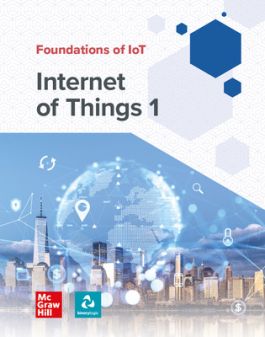Foundations of IoT: Internet of Things 1, Student Print and Online Course, 1-year subscription
1st Edition
126530078X
·
9781265300784
© 2026 | Published: July 31, 2025
Introduce high school students to the rapidly expanding world of connected technology with Foundations of IoT: Internet of Things 1 & 2.Through engaging projects and real-world scenarios, students explore how devices, sensors, microcontrollers, a…
Read More
Receive via shipping:
- Colour, print bound version of the complete text
Introduce high school students to the rapidly expanding world of connected technology with Foundations of IoT: Internet of Things 1 & 2.
Through engaging projects and real-world scenarios, students explore how devices, sensors, microcontrollers, and cloud services work together to build smart systems.
In Foundations of IoT: Internet of Things 1, students learn the fundamentals of IoT and then proceed to build applications by programming Arduino boards to deploy cloud-connected solutions. This course develops critical skills in coding, digital systems, and data analysis.
Foundations of IoT: Internet of Things 2 is an advanced program that enables students to expand their abilities in designing, programming, and securing connected systems for the real world. Learners explore C++ programming, cloud integration, smart messaging protocols, and wireless sensor network simulation, applying their knowledge to hands-on projects that involve smart homes, cities, and industry.
Using either program or both, students prepare themselves for an exciting career in this emerging technology.
Foundations is an innovative series of titles designed for high school students, each covering a specific area of the digital world. These key features of every Foundations program bring skills to life:
Students using Foundations of IoT: Internet of Things 1 will:
Through engaging projects and real-world scenarios, students explore how devices, sensors, microcontrollers, and cloud services work together to build smart systems.
In Foundations of IoT: Internet of Things 1, students learn the fundamentals of IoT and then proceed to build applications by programming Arduino boards to deploy cloud-connected solutions. This course develops critical skills in coding, digital systems, and data analysis.
Foundations of IoT: Internet of Things 2 is an advanced program that enables students to expand their abilities in designing, programming, and securing connected systems for the real world. Learners explore C++ programming, cloud integration, smart messaging protocols, and wireless sensor network simulation, applying their knowledge to hands-on projects that involve smart homes, cities, and industry.
Using either program or both, students prepare themselves for an exciting career in this emerging technology.
Foundations is an innovative series of titles designed for high school students, each covering a specific area of the digital world. These key features of every Foundations program bring skills to life:
- Clear instruction and active learning: Students thrive in their learning when presented with well-de?ned goals, clear instruction, relevant examples, hands-on activities, and project-based learning.
- Timely and relevant coverage: Content aligns with the latest industry practices, preparing students for future careers.
- Complete teacher support: Educators prepare efficiently with a print teacher’s edition, lesson plans, lesson guides, and pre-built assessments.
- Flexible delivery: Students benefit from a hardbound textbook or use the digital resources complete with an eBook, an adaptive SmartBook®, assessment, videos, and more.
Students using Foundations of IoT: Internet of Things 1 will:
- Learn how sensors, actuators, microcontrollers, and cloud services interact in smart systems.
- Build and program real-world IoT projects, including smart homes, automated plant watering systems, and gas leak detection alarms.
- Learn to use tools such as Arduino and cloud-based platforms, along with programming languages like Python, to collect data and develop cloud-connected solutions.
- Explore edge and fog computing concepts and analyze how the Internet of Things (IoT) is utilized in environmental monitoring, smart cities, and other applications.
- Develop digital literacy, coding skills, and systems thinking through scaffolded, hands-on learning and projects.

